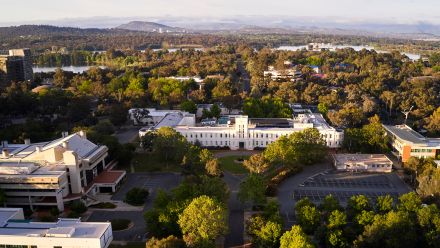Melodies of musical âstarquakesâ shed new light on how our galaxy formed
They say music is the universal language of humankind, but some stars in our galaxy exhibit their own rhythm, offering into how they and our home galaxy, the Milky Way, evolved over time.
According to an international team of researchers, including scientists from şÚÁĎĚěĚĂ (ANU) and UNSW Sydney, some stars exhibit fluctuations in their brightness over time, which are caused by continuous âstarquakesâ.
These fluctuations can be translated into frequencies, which can be used to determine a starâs age and other properties such as its mass.
Study lead author Dr Claudia Reyes from şÚÁĎĚěĚĂimagined stars as musical instruments, each playing a distinct melody.
âStarquakes occur in certain stars, leading to a continuous cycle of brightening and dimming. By carefully observing these tiny fluctuations in brightness, we can listen to a starâs musical rhythm,â Dr Reyes, who completed most of this work during her time at UNSW Sydney, said.
âThese fluctuations are like musical notes, similar to the vibrations of a string or the hum of a drum, that can be translated into frequencies. Each frequency tells us more about the starâs size, chemical composition and internal structure.â
Dr Reyes said that each of the stars they studied has a âshell of energy around its coreâ that helps keep them alive. This region of the star is like a furnace where nuclear reactions take place and elements are formed. These reactions produce very large amounts of energy, and elements produced during these reactions are emitted into the universe.
As a star ages and its mass and internal structure changes â such as when a star evolves into a subgiant or red giant â these so-called furnace regions near their core can become bigger or smaller.
When this happens, a star emits different frequencies, an important discovery that brings scientists a step closer to piecing together the history of the Milky Way.
The researchers studied frequencies emitted by stars in a region of our galaxy known as the âopen cluster M67â, almost 3,000 light years from Earth. Dr Reyes said the research team was interested in these specific stars because they are like siblings â they were born from the same molecular cloud at the same time and therefore share the same age and chemical composition.
Stars in the M67 cluster also share similar qualities to stars close to Earth, such as our Sun.
âWe studied frequencies emitted by stars in this cluster as they evolved into subgiants and red giants â something that had never been fully explored before,â Dr Reyes said.
The scientists discovered that stars in this cluster reach a point in their life where the signature of the frequency they emit temporarily halts once it reaches a certain point, as if the signal were caught in a loop, repeating itself like a broken record, before resuming its progression. Dr Reyes calls this moment the âplateauâ.
âStars have multiple layers, similar to an onion. We discovered that the plateau occurs due to events in a specific layer of the star and at specific frequencies that are influenced by a starâs mass and metallicity,â Dr Reyes said.
âThis means we can predict when and at what frequency the plateau will occur during a starâs life cycle, enabling extremely precise age estimates for stars currently in their plateau phase.
âThis research helps us better understand how stars evolve and provides a new tool to estimate their age, which is crucial for studying the evolution of our galaxy.
"This discovery gives us a new reason to revisit data we already have. With years of seismic observations from across the Milky Way, we can now return to those stars and 'listen' again, this time knowing what to listen for."
The research is published in . This work involved scientists from ANU, UNSW Sydney, the University of Sydney, Yale University, the University of Hawaii and Massachusetts Institute of⯠Technology.


